Recent Advances in Integrated Photonic Jet-Based Photonics
Abstract
1. Introduction
2. Near-Field Curved Beams
3. Subwavelength Curved Localized Light Beams
4. Photonic Jet Array from Phase Diffraction Grating
5. Conclusions
Author Contributions
Funding
Conflicts of Interest
References
- Berry, M.V.; Balazs, N.L. Nonspreading wave packets. Am. J. Phys. 1979, 47, 264–267. [Google Scholar] [CrossRef]
- Siviloglou, G.A.; Broky, J.; Dogariu, A.; Christodoulides, D.N. Observation of accelerating Airy beams. Phys. Rev. Lett. 2007, 99, 213901. [Google Scholar] [CrossRef] [PubMed]
- Greenfield, E.; Segev, M.; Walasik, W.; Raz, O. Accelerating light beams along arbitrary convex trajectories. Phys. Rev. Lett. 2011, 106, 213902. [Google Scholar] [CrossRef] [PubMed]
- Kaminer, I.; Bekenstein, R.; Nemirovsky, J.; Segev, M. Nondiffracting accelerating wave packets of Maxwell’s equations. Phys. Rev. Lett. 2012, 108, 163901. [Google Scholar] [CrossRef] [PubMed]
- Zhang, P.; Hu, Y.; Li, T.; Cannan, D.; Yin, X.; Morandotti, R.; Chen, Z.; Zhang, X. Nonparaxial Mathieu and Weber accelerating beams. Phys. Rev. Lett. 2012, 109, 193901. [Google Scholar] [CrossRef]
- Aleahmad, P.; Miri, M.A.; Mills, M.S.; Kaminer, I.; Segev, M.; Christodoulides, D.N. Fully vectorial accelerating diffraction-free Helmholtz beams. Phys. Rev. Lett. 2012, 109, 203902. [Google Scholar] [CrossRef]
- Baumgartl, J.; Mazilu, M.; Dholakia, K. Optically mediated particle clearing using Airy wavepackets. Nat. Photonics 2008, 2, 675–678. [Google Scholar] [CrossRef]
- Polynkin, P.; Koleskik, M.; Moloney, J.V.; Siviloglou, G.A.; Christodoulides, D.N. Curved plasma channel generation using ultraintense Airy beams. Science 2009, 324, 229–232. [Google Scholar] [CrossRef]
- Lin, J.; Dellinger, J.; Genevet, P.; Cluzel, B.; de Fornel, F.; Capasso, F. Cosine-gauss plasmon beam: A localized long-range nondiffracting surface wave. Phys. Rev. Lett. 2012, 109, 093904. [Google Scholar] [CrossRef]
- Li, L.; Li, T.; Wang, S.M.; Zhu, S.N. Collimated plasmon beam: Nondiffracting versus linearly focused. Phys. Rev. Lett. 2013, 110, 046807. [Google Scholar] [CrossRef]
- Ellenbogen, T.; Voloch-Bloch, N.; Ganany-Padowicz, A.; Arie, A. Nonlinear generation and manipulation of Airy beams. Nat. Photonics 2009, 3, 395–398. [Google Scholar] [CrossRef]
- Voloch-Bloch, N.; Lereah, Y.; Lilach, Y.; Gover, A.; Arie, A. Generation of electron Airy beams. Nature 2013, 494, 331–335. [Google Scholar] [CrossRef] [PubMed]
- Efremidis, N.K.; Chen, Z.; Segev, M.; Christodoulides, D.N. Airy beams and accelerating waves: An overview of recent advances. Optica 2019, 6, 686–701. [Google Scholar] [CrossRef]
- Froehl, L.; Froehly, L.; Courvoisier, F.; Mathis, A.; Jacquot, M.; Furfaro, L.; Giust, R.; Lacourt, P.A.; Dudley, J.M. Arbitrary accelerating micron-scale caustic beams in two and three dimensions. Opt. Express 2011, 19, 16455–16465. [Google Scholar] [CrossRef] [PubMed]
- Gao, N.; Li, H.; Zhu, X.; Hua, Y.; Xie, C. Quasi-periodic gratings: Diffraction orders accelerate along curves. Opt. Lett. 2013, 38, 2829–2831. [Google Scholar] [CrossRef]
- He, J.; Wang, S.; Xie, Z.; Ye, J.; Wang, X.; Kan, Q.; Zhang, Y. Abruptly autofocusing terahertz waves with meta-hologram. Opt. Lett. 2016, 41, 2787–2790. [Google Scholar] [CrossRef]
- Kondakci, H.E.; Abouraddy, A.F. Airy wave packets accelerating in space-time. Phys. Rev. Lett. 2018, 120, 163901. [Google Scholar] [CrossRef]
- Durnin, J.; Miceli, J.J.; Eberly, J.H. Diffraction-free beams. Phys. Rev. Lett. 1987, 58, 1499–1501. [Google Scholar] [CrossRef]
- Matijošius, A.; Jarutis, V.; Piskarskas, A. Generation and control of the spiraling zero-order Bessel beam. Opt. Express 2010, 18, 8767–8771. [Google Scholar] [CrossRef]
- Morris, J.; Cizmar, T.; Dalgarno, H.; Marchington, R.; Gunn-Moore, F.; Dholakia, K. Realization of curved Bessel beams: Propagation around obstructions. J. Opt. 2010, 12, 124002. [Google Scholar] [CrossRef]
- Chremmos, I.D.; Chen, Z.; Christodoulides, D.N.; Efremidis, N.K. Bessel-like optical beams with arbitrary trajectories. Opt. Lett. 2012, 37, 5003–5005. [Google Scholar] [CrossRef] [PubMed]
- Zhao, J.; Zhang, P.; Deng, D.; Liu, J.; Gao, Y.; Chremmos, I.D.; Efremidis, N.K.; Christodoulides, D.N.; Chen, Z. Observation of selfaccelerating Bessel-like optical beams along arbitrary trajectories. Opt. Lett. 2013, 38, 498–500. [Google Scholar] [CrossRef] [PubMed]
- Zhao, J.; Chremmos, I.D.; Song, D.; Christodoulides, D.N.; Efremidis, N.K.; Chen, Z. Curved singular beams for three-dimensional particle manipulation. Sci. Rep. 2015, 5, 12086. [Google Scholar] [CrossRef] [PubMed]
- Vettenburg, T.; Dalgarno, H.; Nylk, J.; Coll-Lladó, C.; Ferrier, D.; Čižmár, T.; Gunn-Moore, F.; Dholakia, K. Light-sheet microscopy using an Airy beam. Nat. Methods 2014, 11, 541–544. [Google Scholar] [CrossRef]
- Domenico, G.; Ruocco, G.; Colosi, C.; DelRe, E.; Antonacci, G. Cancellation of Bessel beam side lobes for high-contrast light sheet microscopy. Sci. Rep. 2018, 8, 17178. [Google Scholar] [CrossRef] [PubMed]
- Chan, W.L.; Chen, H.; Taylor, A.J.; Brener, I.; Cich, M.J.; Mittleman, D.M. A spatial light modulator for terahertz beams. Appl. Phys. Lett. 2009, 94, 213511. [Google Scholar] [CrossRef]
- Valdmann, A.; Piksarv, P.; Valtna-Lukner, H.; Saari, P. White-light hyperbolic Airy beams. J. Opt. 2018, 20, 095605. [Google Scholar] [CrossRef]
- Kopylov, Y.V.; Popov, A.V. Diffraction phenomena inside thick Fresnel zone plates. Radio Sci. 1996, 31, 1815–1822. [Google Scholar] [CrossRef]
- Born, M.; Wolf, E. Principles of Optics, 6th ed.; Pergamon: Oxford, UK, 1986. [Google Scholar]
- Pacheco-Peña, V.; Beruete, M.; Minin, I.V.; Minin, O.V. Terajets produced by dielectric cuboids. Appl. Phys. Lett. 2014, 105, 084102. [Google Scholar] [CrossRef]
- Minin, O.V.; Minin, I.V. Terahertz artificial dielectric cuboid lens on substrate for super-resolution images. Opt. Quantum Electron. 2017, 49, 326–329. [Google Scholar] [CrossRef]
- Heifetz, A.; Kong, S.; Sahakian, A.; Taflove, A.; Backman, V. Photonic nanojets. J. Comput. Theor. Nanosci. 2009, 6, 1979–1992. [Google Scholar] [CrossRef]
- Liu, C.; Wang, Y. Real-space observation of photonic nanojet in dielectric microspheres. Physica E 2014, 61, 141–147. [Google Scholar] [CrossRef]
- Luk’yanchuk, B.; Paniagua-Domínguez, R.; Minin, I.V.; Minin, O.V.; Wang, Z. Refractive index less than two: Photonic nanojets yesterday, today and tomorrow. Opt. Mater. Express 2017, 7, 1820–1847. [Google Scholar] [CrossRef]
- Arya, A.; Laha, R.; Das, G.M.; Dantham, V.R. Enhancement of Raman scattering signal using photonic nanojet of portable and reusable single microstructures. J. Raman Spectrosc. 2018, 49, 897–902. [Google Scholar] [CrossRef]
- Zhang, X.; Chen, I.; Chang, C. Recent progress in near-field nanolithography using light interactions with colloidal particles: From nanospheres to three-dimensional nanostructures. Nanotechnology 2019, 30, 352002. [Google Scholar] [CrossRef] [PubMed]
- Minin, I.V.; Minin, O.V. Diffractive Optics and Nanophotonics: Resolution below the Diffraction Limit; Springer: Berlin, Germany, 2016. [Google Scholar]
- Geints, Y.; Panina, E.K.; Zemlyanov, A.A. Control over parameters of photonic nanojets of dielectric microspheres. Opt. Commun. 2010, 283, 4775–4781. [Google Scholar] [CrossRef]
- Cao, Y.; Liu, Z.; Minin, O.V.; Minin, I.V. Deep subwavelength-scale light focusing and confinement in nanohole-structured mesoscale dielectric spheres. Nanomaterials 2019, 9, 186. [Google Scholar] [CrossRef]
- Wang, Z.; Luk’yanchuk, B.; Yue, L.; Paniagua-Domínguez, R.; Yan, B.; Monks, J.; Minin, O.V.; Minin, I.V.; Huang, S.; Fedyanin, A. High order Fano resonances and giant magnetic fields in dielectric microspheres. Sci. Rep. 2019, 9, 20293. [Google Scholar] [CrossRef]
- Yue, L.; Yan, B.; Monks, J.; Dhama, R.; Jiang, C.; Minin, O.V.; Minin, I.V.; Wang, Z. Full three-dimensional Poynting vector analysis of great field-intensity enhancement in a specifically sized spherical-particle. Sci. Rep. 2019, 9, 20224. [Google Scholar] [CrossRef]
- Dholakia, K.; Bruce, G. Optical hooks. Nat. Photonics 2019, 13, 229–230. [Google Scholar] [CrossRef]
- Yue, L.; Minin, O.V.; Wang, Z.; Monks, J.; Shalin, A.; Minin, I.V. Photonic hook: A new curved light beam. Opt. Lett. 2018, 43, 771–774. [Google Scholar] [CrossRef]
- Ang, A.; Karabchevsky, A.; Minin, I.V.; Minin, O.V.; Sukhov, S.; Shalin, A. Photonic Hook based optomechanical nanoparticle manipulator. Sci. Rep. 2018, 8, 2029. [Google Scholar] [CrossRef] [PubMed]
- Spector, M.; Ang, A.; Minin, O.V.; Minin, I.V.; Karabchevsky, A. Temperature mediated ‘Photonic hook’ nanoparticle manipulator with pulsed illumination. Nanoscale Adv. 2020. [Google Scholar] [CrossRef]
- Minin, I.V.; Minin, I.V.; Katyba, G.; Chernomyrdin, N.; Kurlov, V.; Zaytsev, K.; Yue, L.; Wang, Z.; Christodoulides, D. Experimental observation of a photonic hook. Appl. Phys. Lett. 2019, 114, 031105. [Google Scholar] [CrossRef]
- Rubio, C.; Tarrazó-Serrano, D.; Minin, O.V.; Uris, A.; Minin, I.V. Acoustical hooks: A new subwavelength self-bending beam. Results Phys. 2020, 16, 102921. [Google Scholar] [CrossRef]
- Minin, I.V.; Minin, O.V.; Ponomarev, D.S.; Glinskiy, I.A. Photonic hook plasmons: A new curved surface wave. Ann. Phys. 2018, 530, 1800359. [Google Scholar] [CrossRef]
- Minin, I.V.; Minin, O.V.; Glinskiy, I.A.; Khabibullin, R.A.; Malureanu, R.; Yakubovsky, D.I.; Volkov, V.; Ponomarev, D.S. Experimental verification of a plasmonic hook in a dielectric Janus particle. arXiv 2020, arXiv:2004.10749. [Google Scholar]
- Yang, J.; Twardowski, P.; Gérard, P.; Duo, Y.; Fontaine, J.; Lecler, S. Ultra-narrow photonic nanojets through a glass cuboid embedded in a dielectric cylinder. Opt. Express 2018, 26, 3723–3731. [Google Scholar] [CrossRef]
- Xing, E.; Gao, H.; Rong, J.; Khew, S.; Liu, H.; Tong, C.; Hong, M. Dynamically tunable multi-lobe laser generation via multifocal curved beam. Opt. Express 2018, 26, 30944–30951. [Google Scholar] [CrossRef]
- Minin, I.V.; Minin, O.V.; Liu, C.-Y.; Wei, H.-D.; Karabchevsky, A. Simulation and experimental observation of tunable photonic nanojet and photonic hook upon asymmetric illumination of a mesoscale cylinder with mask. arXiv 2020, arXiv:2004.05911. [Google Scholar]
- Huang, Y.; Zhen, Z.; Shen, Y.; Min, C.; Veronis, G. Optimization of photonic nanojets generated by multilayer microcylinders with a genetic algorithm. Opt. Express 2019, 27, 1310–1325. [Google Scholar] [CrossRef] [PubMed]
- Minin, I.V.; Minin, O.V. Subwavelength Self-Bending Structured Light Beams. Carbon Nanostructures and their Electromagnetic Properties. In Proceedings of the Fourth Russian-Belarusian Workshop, Tomsk, Russia, 21–24 April 2019; pp. 52–57. [Google Scholar]
- Minin, I.V.; Minin, O.V. Dielectric particle-based strategy to design a new self-bending subwavelength structured light beams. In Proceedings of the 14th International Forum on Strategic Technology, Tomsk, Russia, 14–17 October 2019; p. 23. [Google Scholar]
- Gu, G.; Shao, L.; Song, J.; Qu, J.; Zheng, K.; Shen, X.; Peng, Z.; Hu, J.; Chen, X.; Chen, M.; et al. Photonic hooks from Janus microcylinders. Opt. Express 2019, 27, 37771–37780. [Google Scholar] [CrossRef] [PubMed]
- Shen, X.; Gu, G.; Shao, L.; Peng, Z.; Hu, J.; Bandyopadhyay, S.; Liu, Y.; Jiang, J.; Chen, M. Twin photonic hook generated by twin-ellipse microcylinder. IEEE Photonics J. 2020, 12. [Google Scholar] [CrossRef]
- Ang, A.S.; Minin, I.V.; Minin, O.V.; Sukhov, S.V.; Shalin, A.; Karabchevsky, A. Low-Contrast Photonic Hook Manipulator for Cellular Differentiation. In Proceedings of the 9th International Conference on Metamaterials, Photonic Crystals and Plasmonics, Marseille, France, 24 June–1 July 2018. [Google Scholar]
- Geints, Y.E.; Minin, I.V.; Minin, O.V. Tailoring “photonic hook” from Janus dielectric microbar. J. Opt. 2020, 22, 065606. [Google Scholar] [CrossRef]
- Ma, X.; Guo, Y.; Pu, M.; Jin, J.J.; Gao, P.; Li, X.; Luo, X. Tunable optical hooks in the visible band based on ultra-thin metalenses. Ann. Phys. 2020, 532, 1900396. [Google Scholar] [CrossRef]
- Taflove, A.; Hagness, S. Computational Electrodynamics: The Finite Difference Time Domain Method; Artech House: Norwood, MA, USA, 1998. [Google Scholar]
- Geints, Y.; Zemlyanov, A. Modeling spatially localized photonic nanojets from phase diffraction gratings. J. Appl. Phys. 2016, 119, 153101. [Google Scholar] [CrossRef]
- Liu, C.; Minin, O.V.; Minin, I.V. First experimental observation of array of photonic jets from saw-tooth phase diffraction grating. EPL 2018, 123, 54003. [Google Scholar] [CrossRef]
- Liu, C.; Yen, T.; Minin, O.V.; Minin, I.V. Theoretical and experimental investigations of photonic jet array from rectangle phase diffraction grating. In Proceedings of the SPIE 10712, Optical Manipulation Conference, 107121H, Yokohama, Japan, 24 April 2018. [Google Scholar]
- Zhang, Y.; Lo, C.; Taylor, J.; Yang, S. Replica molding of high-aspect-ratio polymeric nanopillar arrays with high fidelity. Langmuir 2006, 22, 8595–8601. [Google Scholar] [CrossRef]
- Geints, Y.; Minin, O.V.; Minin, I.V. Apodization—Assisted subdiffraction near-field focusing in 2D phase diffraction grating. Ann. Phys. 2019, 531, 1900033. [Google Scholar] [CrossRef]
- Geints, Y.; Minin, O.V.; Minin, I.V.; Zemlyanov, A. Self-images contrast enhancement for displacement Talbot lithography by means of composite mesoscale amplitude-phase masks. J. Opt. 2019, 22, 015002. [Google Scholar] [CrossRef]
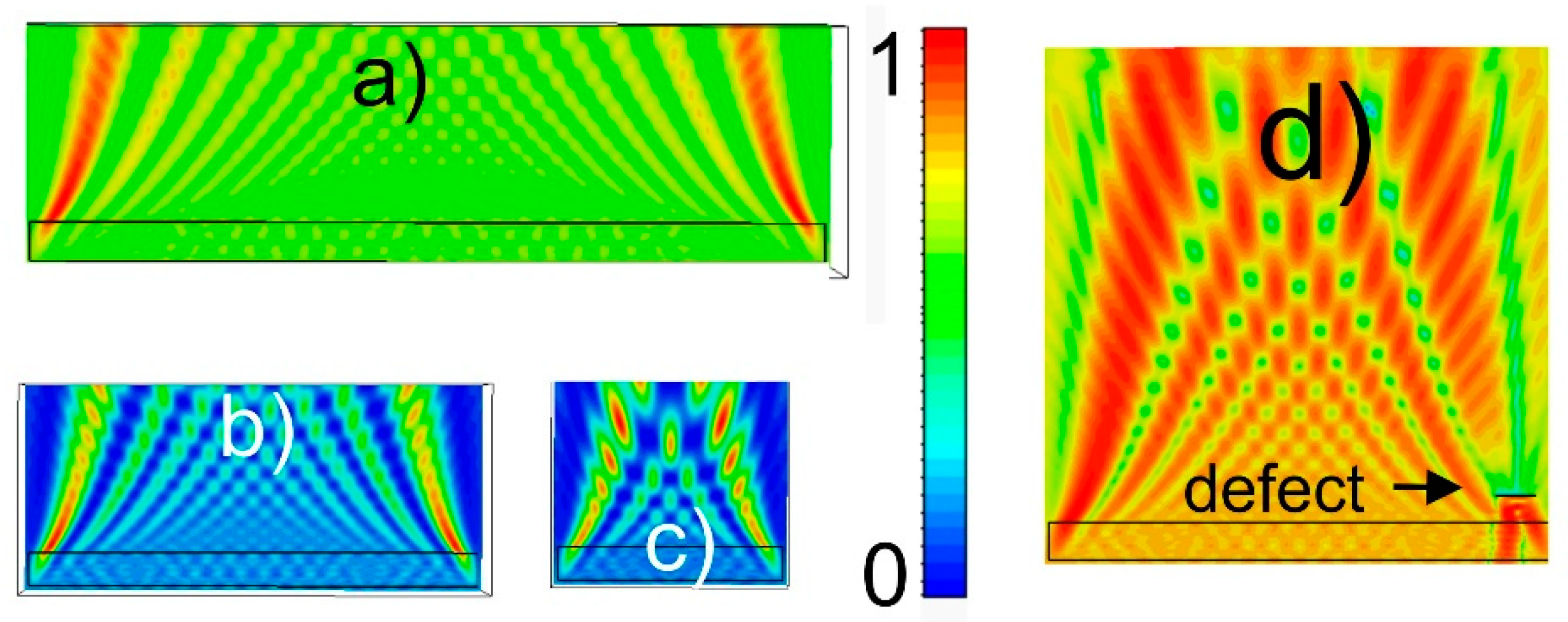
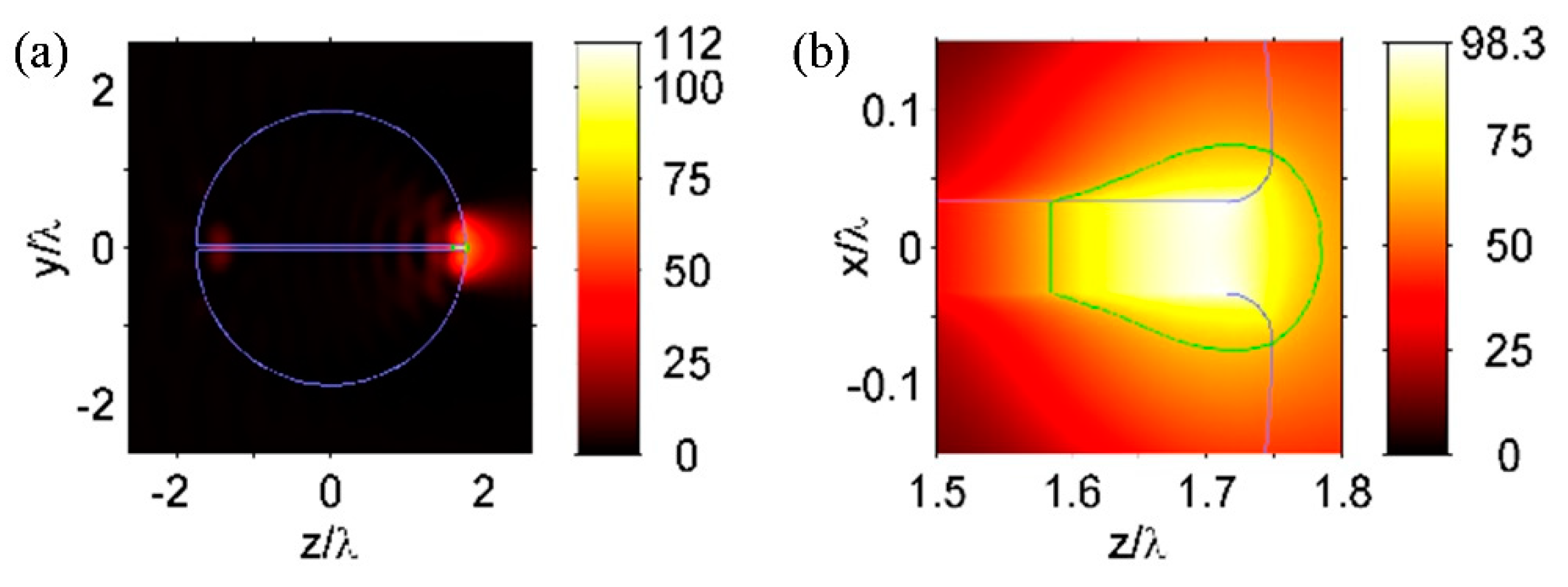

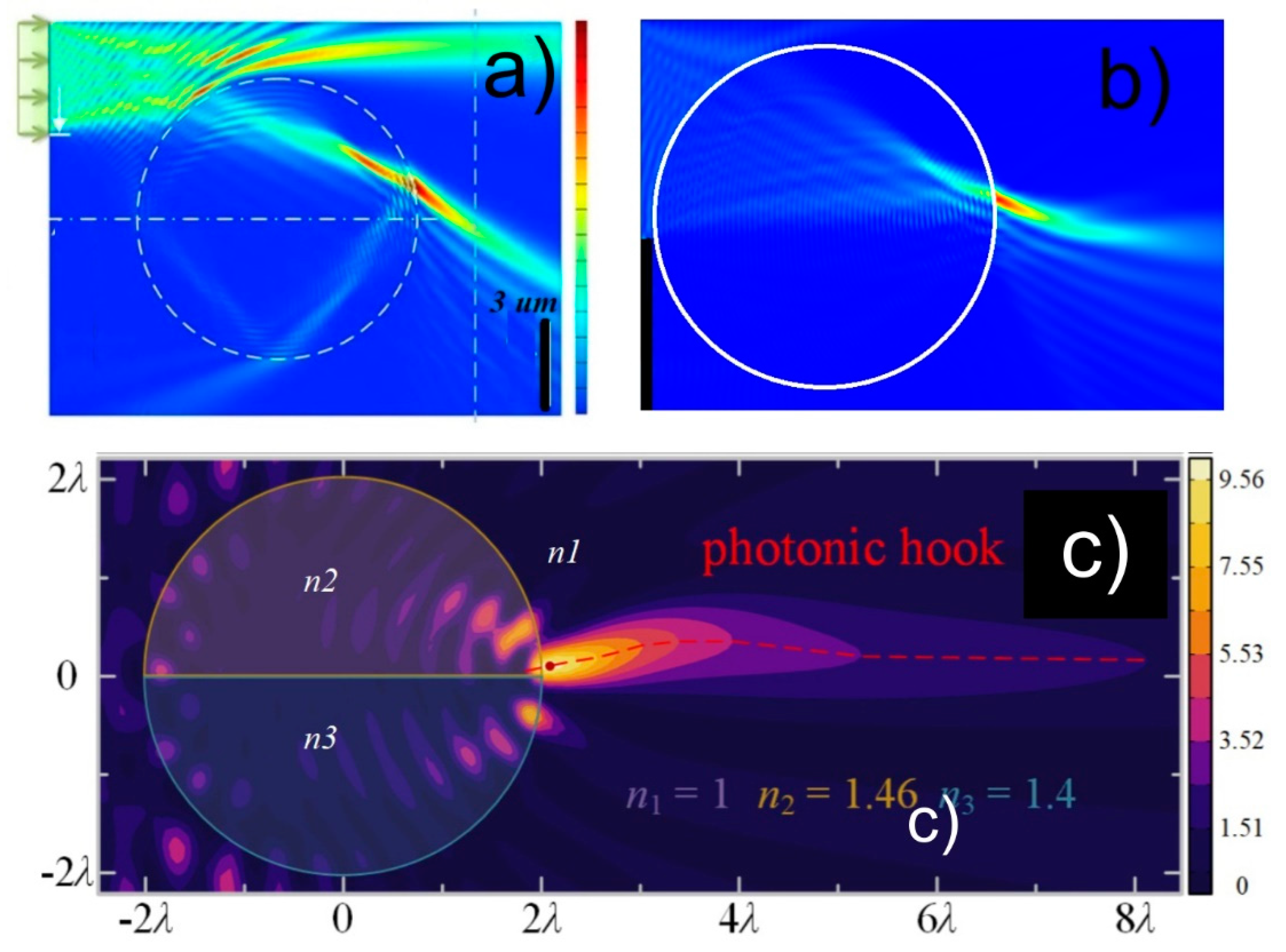
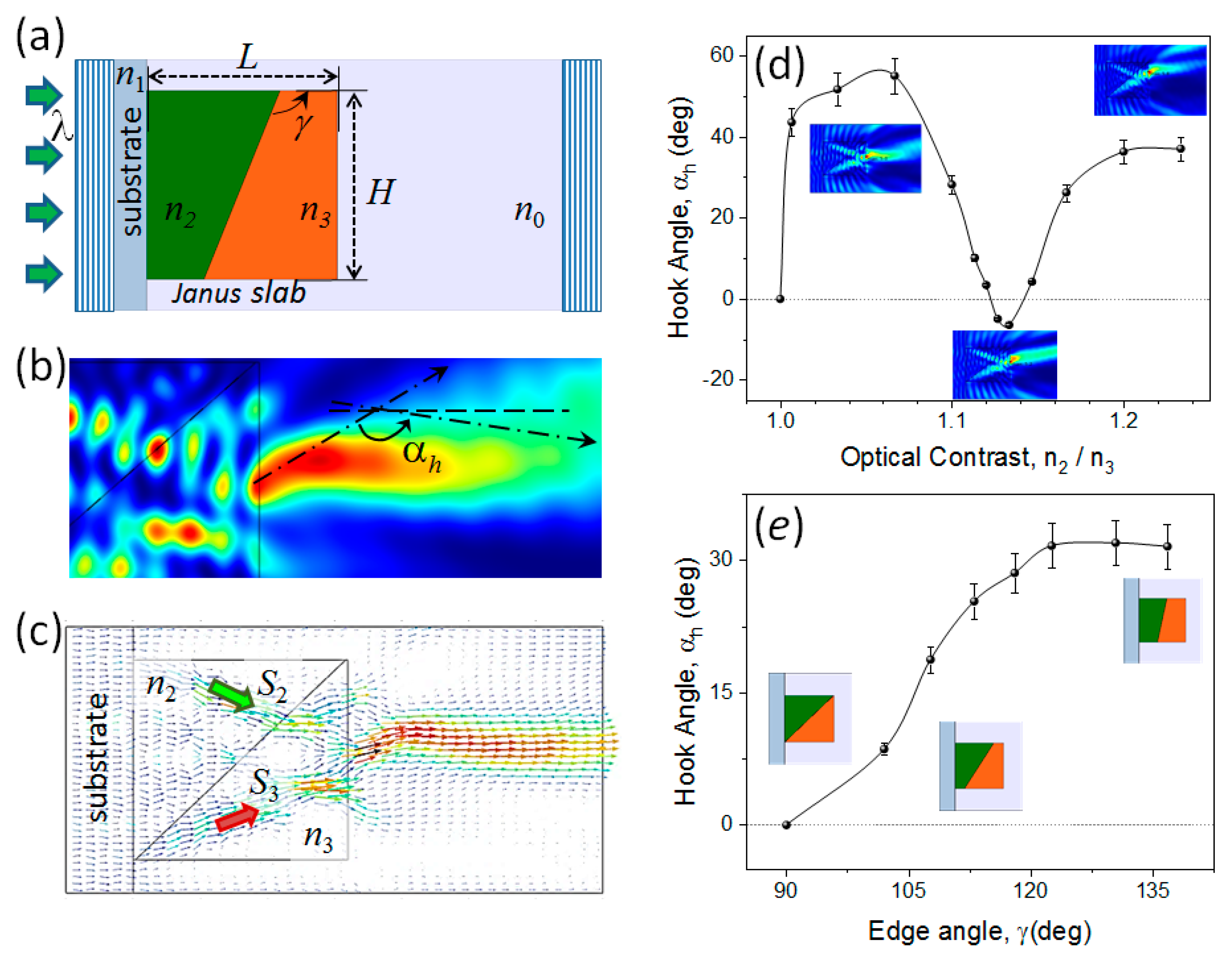
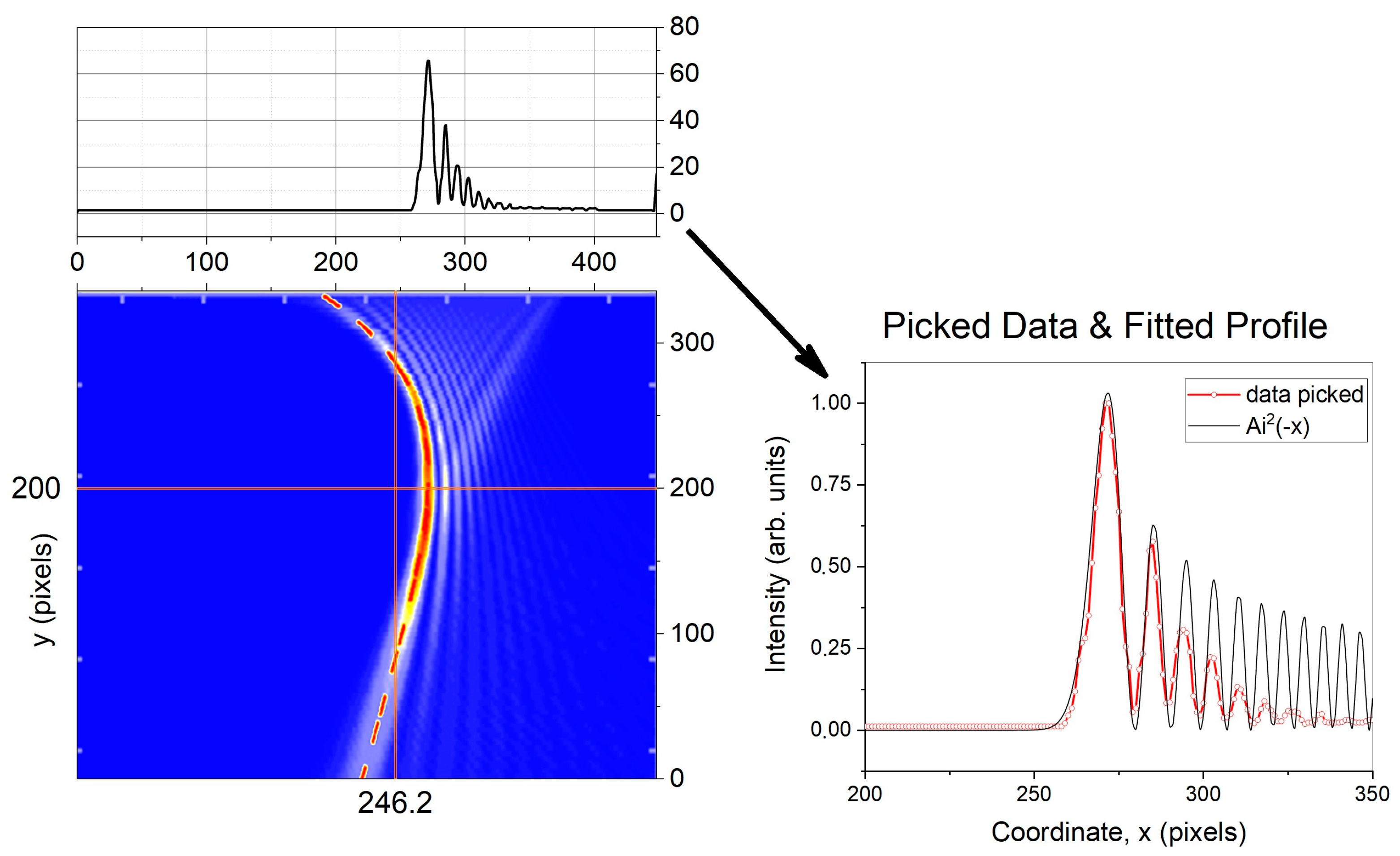
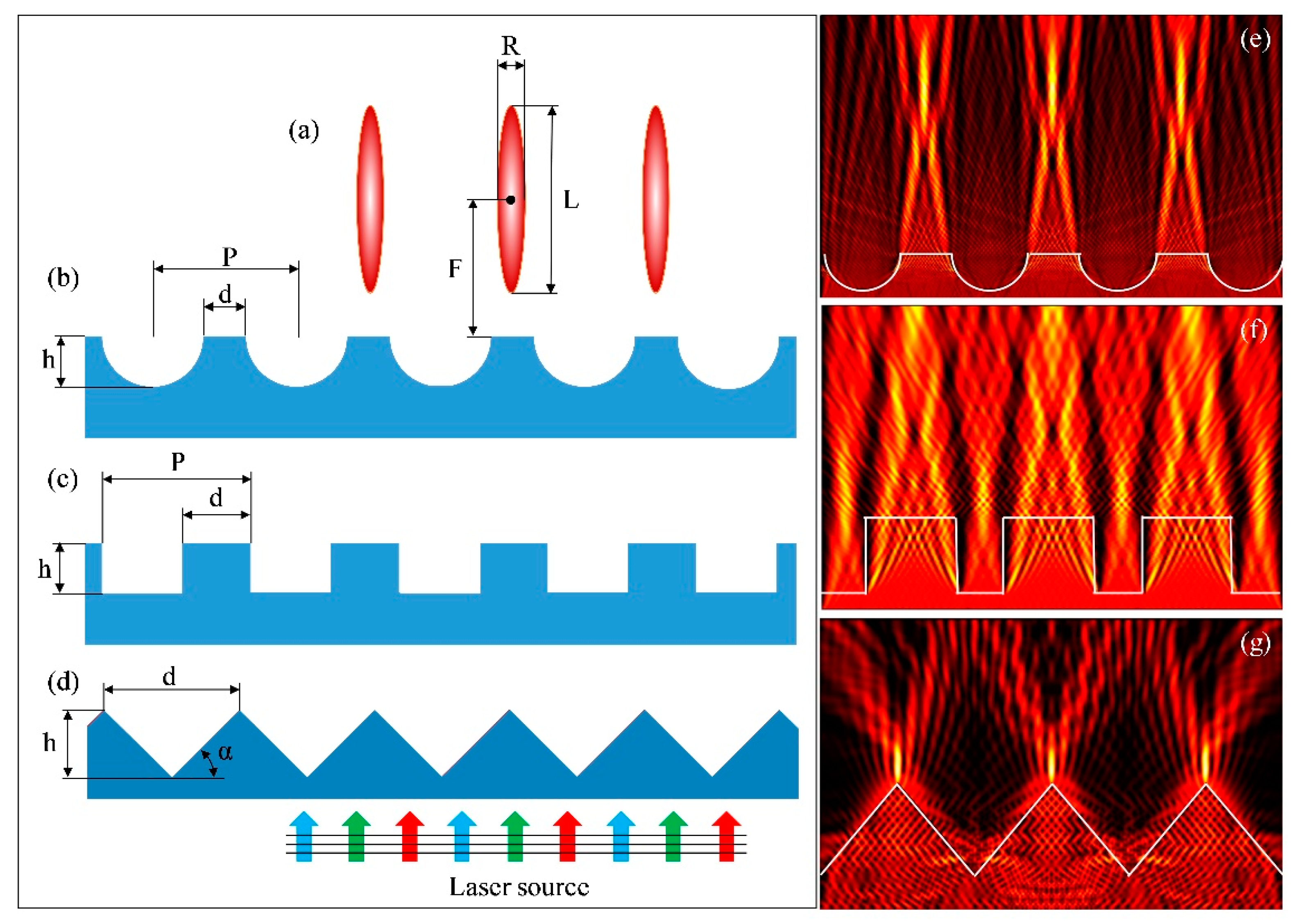
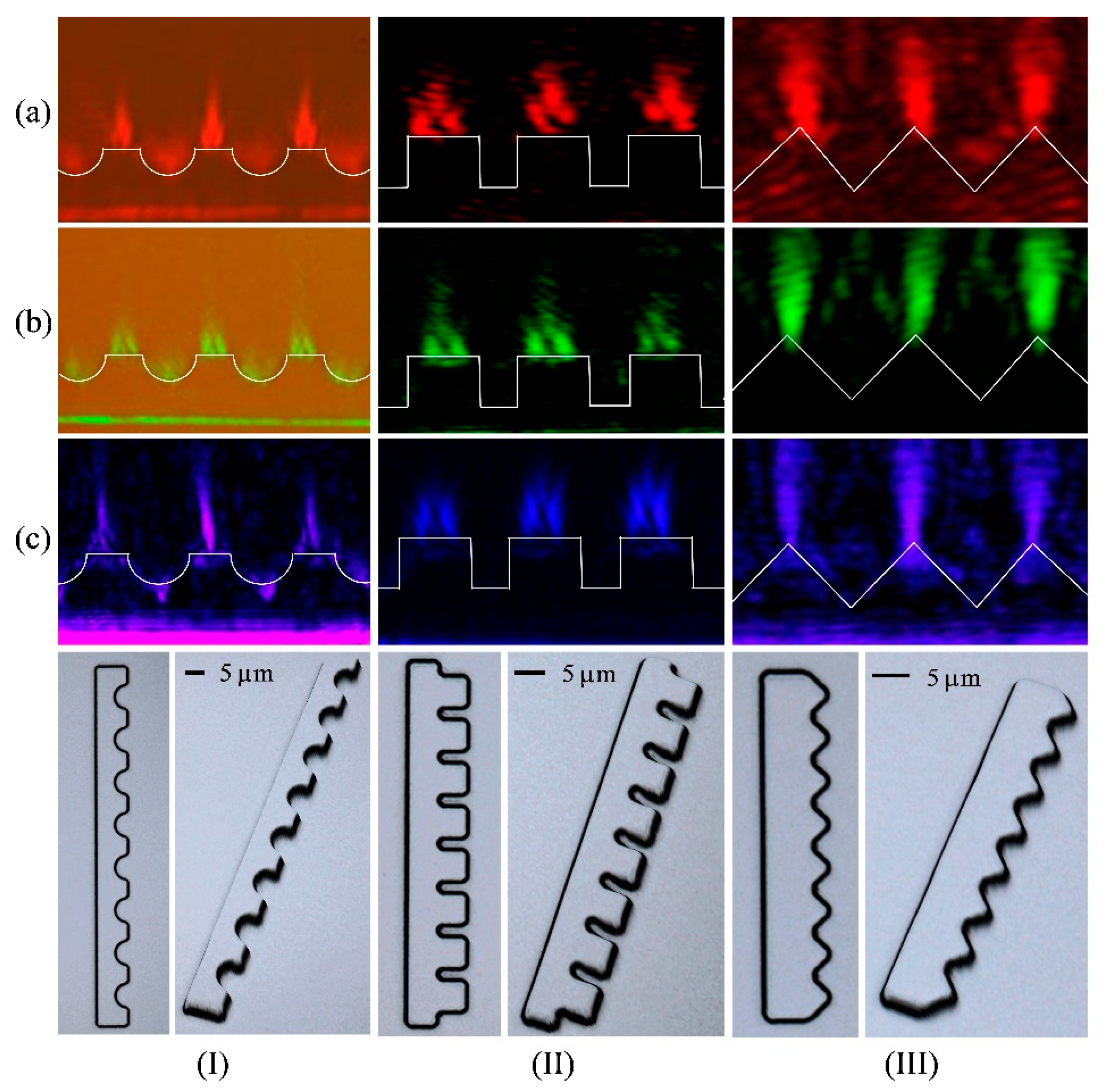
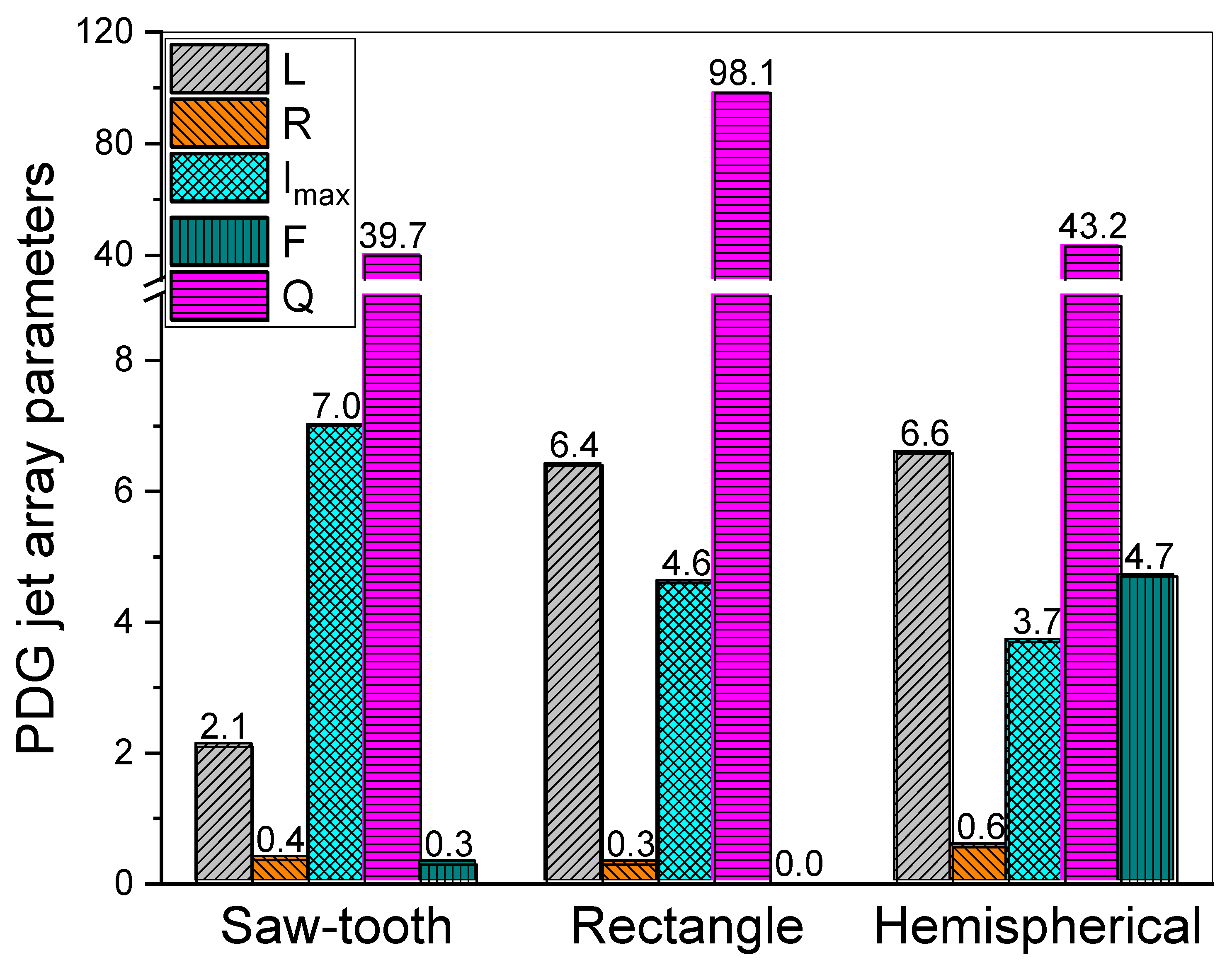
© 2020 by the authors. Licensee MDPI, Basel, Switzerland. This article is an open access article distributed under the terms and conditions of the Creative Commons Attribution (CC BY) license (http://creativecommons.org/licenses/by/4.0/).
Share and Cite
Minin, I.V.; Liu, C.-Y.; Geints, Y.E.; Minin, O.V. Recent Advances in Integrated Photonic Jet-Based Photonics. Photonics 2020, 7, 41. https://doi.org/10.3390/photonics7020041
Minin IV, Liu C-Y, Geints YE, Minin OV. Recent Advances in Integrated Photonic Jet-Based Photonics. Photonics. 2020; 7(2):41. https://doi.org/10.3390/photonics7020041
Chicago/Turabian StyleMinin, Igor V., Cheng-Yang Liu, Yury E. Geints, and Oleg V. Minin. 2020. "Recent Advances in Integrated Photonic Jet-Based Photonics" Photonics 7, no. 2: 41. https://doi.org/10.3390/photonics7020041
APA StyleMinin, I. V., Liu, C.-Y., Geints, Y. E., & Minin, O. V. (2020). Recent Advances in Integrated Photonic Jet-Based Photonics. Photonics, 7(2), 41. https://doi.org/10.3390/photonics7020041







